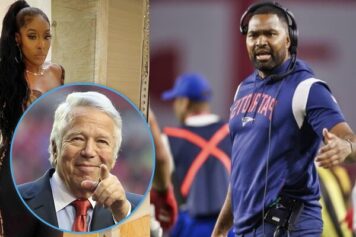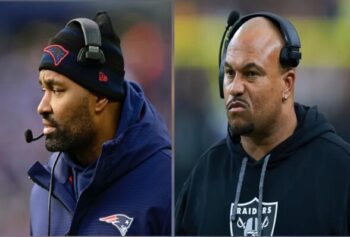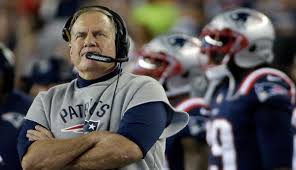Though Aaron Hernandez's arrest has been major news, there hasn't been a heavy dose of opinion from the media. The case deals with many complex issues while sterotypes and generalizations tend to lead the conversation in this type of scenario. Many in the media have, thus far, chosen to remain observers until the facts present themselves, lest they become the next writer to cast off a Duke lacrosse team or Ray Lewis.
However, there have been a few writers who have chosen to dabble. Here is a summary:
Connor Simpson from The Atlantic writes about Hernandez's background and the inevitable dirt that came up in the search:
The vetting of Aaron Hernandez's spotty past has continued and, well, things still aren't looking great for the former New England Patriots star. There's the damning pre-draft psych test, an even more detailed history of trouble, a dead witness, a behind-bars marriage, and now almost unredacted police reports tying him to a 2007 double shooting. Just another day in the twisting saga of the bad-boy tight end turned accused assassin.
As we predicted yesterday , the vetting of Aaron Hernandez and his history of violence has begun, and this time it's more than just a fight spawned by a sucker punch outside a Gainsville bar . ESPN'sOutside the Lines dug up the police reports about the 2007 double shooting to which Hernandez has been connected. Hernandez was a minor at the time, so his name is redacted throughout most of the report, but this is what they could come up with: Florida Gators teammates Aaron Hernandez, Mike Pouncey, Maurkice Pouncey, and UF alumnus Reggie Nelson (then a Jacksonville Jaguars rookie) went to the Venue nightclub in Gainesville, Florida on September 30, 2007. While partying in the club, according to the police report, Hernandez told Nelson about Randall Cason, another patron, who he said had stolen his necklace. They had beef, essentially. When Cason left with two friends, Corey Smith and Justin Glass, their car was fired upon while stopped a few blocks later. Two men approached the vehicle and shots rang out. Cason originally fingered Hernandez and Nelson as the shooters.
The Hartford Courant reports a man police were looking for in the Lloyd case died in a single car accident on Sunday evening, driving a car registered under Hernandez's uncle's name. Investigators were ready to speak with Thaddeus Singleton III, a 33-year-old with a rap sheet full of drug convictions, about his relation to Hernandez. Then, Sunday night, the car he was driving "shot 100 feet through the air and hit the Farmington Country Club 6 feet off the ground." There was a passenger in the car, too, who survived the crash. There's no evidence suggesting the crash was suspect in any way, but it's hard not to look at the the timing.
Elsewhere, the psychological profile of Hernandez is also growing, along with the documenting his history of violence. The Wall Street Journal reports Hernandez received the lowest possible score , a one out of ten, on a pre-NFL draft psychological test under "social maturity." While he received high marks for all of the football related categories, the test painted him as enjoying "living on the edge of acceptable behavior." It warned he could become "a problem" later in his career.
Sally Jenkins from the Washington Post takes on the typical culprits in the media who are blowing Hernandez's situation out of proportion in "Aaron Hernandez unfairly stigmatizes NFL players as violent and criminalized." She writes:
Hernandez’s example has become Exhibit A for braying commentators who have painted the entire league in stigmas as crude as snake and dagger tattoos. Rivera denounced the league’s “jungle ethos” and — incredibly — described NFL players as “fatherless” products recruited from the “inner city” in need of “minders.” Actually, Hernandez was not fatherless, and he’s from middle-class Connecticut suburbs, not the inner city, and we all know what that 1970s euphemism means. It means poor and non-white and therefore brutal. Rivera was followed closely by Limbaugh, who said, “This has the potential to blow the lid open on the NFL and gangs and the whole concept.”
Here is a fact that you may find hard to believe after listening to them: NFL players commit crimes at a much lower rate than their peers in the general population. Around 2,700 players pass through NFL training camps every season, and 1,696 make rosters. Yes, some of them get arrested — about 2 to 3 percent a year. The national arrest rate for males aged 22 to 34? It’s 10.8 percent, according to FBI crime statistics for 2009.
Jenkins continues:
But the NFL is not the only organization that unwittingly harbors criminals. The military had 26,000 cases of sexual assault last year. And for sheer volume of criminal activity, don’t look at the NFL; look at financial institutions, which in 2011 accounted for 1,719 FBI cases. The statistics suggest the men who play football are, on the whole, less criminally violent than soldiers and more ethically respectable than looters with Harvard MBAs who commit acts of grand larceny with “financial instruments.” Or the middle management creeps employed by Cleveland Browns owner Jim Haslam at Pilot Oil, who have pleaded guilty to bilking long-haul truckers.
The league constantly deals with stereotype. It fights an ongoing war against portrayals of players as gun brandishing, wife-beating, uneducated, morally bankrupt, assaulting criminals. In fact, 80 percent of retired NFL players over the age of 50 have college degrees, compared with 30 percent of the general population, according to a University of Michigan study. That same survey said 64 percent of NFL retirees between the ages of 30 and 49 found are still married to their first wife. As a group they are more committed and disciplined than most employees, evince deep loyalty to their bosses and colleagues and sacrifice their long-term health for their families. In return for which they get ranted at by fans for being overpaid and stigmatized as thugs by foaming commentators in need of story lines.
Jason Whitlock continues on with the same themes he's been writing about for "two decades" on FoxSports.com, and discusses cultural issues surrounding Hernandez.
He repped the 860. He kept it real. He stayed true to his boyz from the 'hood. He mimicked the mindset of the pop-culture icons we celebrate today.
This is what a 40-year drug war, mass incarceration, a steady stream of Mafia movies, three decades of gangster rap and two decades of reality TV have wrought: athletes who covet the rebellious and marketable gangster persona.
Hernandez is the most extreme example. He apparently moonlighted as a professional football player while perfecting his role as Christopher Moltisanti, Tony Soprano’s boneheaded nephew.
But we should not be shocked that a professional athlete possibly crossed the line into sociopathic killer. The unhealthy side effects of drug prohibition and popular culture have made murderous drug dealers respected members of American society. Random, murderous violence and the people who commit those crimes have been normalized in America, thanks in large part to popular culture.
Ian Crouch at The New Yorker tackles the difficult situation that arises when crime and sports mix, particularly for the fans.
For fans, Hernandez’s value is mostly measured in statistics, making it difficult, in the serious moments of real life, to stop thinking of him or any athlete as anything other than a component on a favorite team. This is especially true of football, with its large rosters, complex on-field schemes, non-guaranteed contracts, and fragile players—perhaps more than with any other sport, the fans are rooting for logos and colors. The popularity of fantasy football, and the game’s natural compartmentalization into precise skill sets, has only exacerbated this, shrinking all but the most famous N.F.L. players down to discrete commodities, and creating an atmosphere in which Aaron Hernandez’s legal status isn’t a question of one life ended and another in jeopardy, but just another factor in judging a tight end’s utility and availability.



